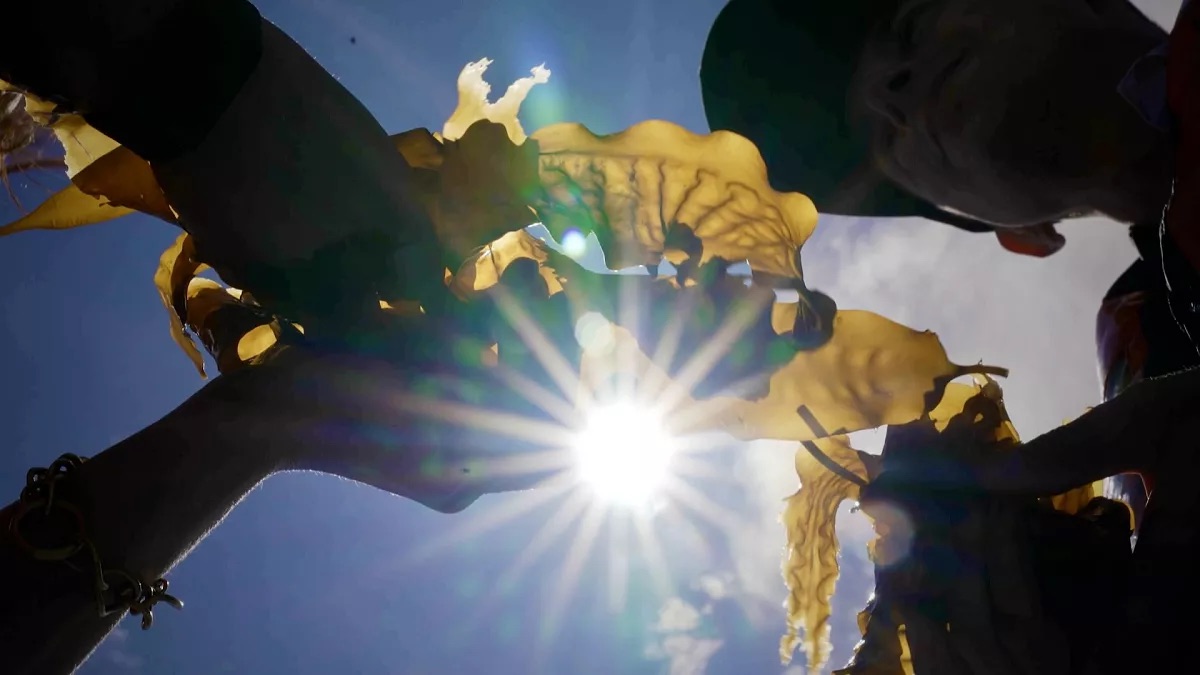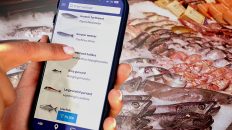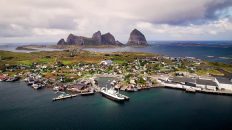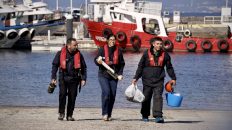Europe’s offshore wind farms are being reimagined as multi-purpose sites. The first commercial-scale project has successfully harvested seaweed between turbines in the Dutch North Sea.
Eighteen kilometres off the Dutch coast, giant turbines spin steadily, harvesting wind energy in the waters of the Hollandse Kust Zuid offshore park — the world’s largest built without government subsidies. But between the towering turbines, a new kind of harvest is underway.
Floating in the waters, sheltered from vessel traffic, is North Sea Farm 1, a five-hectare experimental seaweed plantation. It is part of a pioneering experiment to combine offshore wind energy with ocean farming — and it just yielded its first crop.
Space to grow
Unlike nearshore seaweed farms, which are facing tough competition for space and busy human activity, offshore locations offer quieter waters, free from shipping traffic. But they also come with technical and financial challenges.
“This is much more challenging technically,” explains Eef Brouwers, general manager of the non-profit North Sea Farmers, which runs the project. “The sea is rougher, it’s usually deeper, so you need more material for your farm. Nearshore is much easier. However, there is also limited nearshore space. So where will you grow seaweed? Where will you scale up for the coming 10-20 years? You need another solution. You need to test it and do it offshore.”
The team hopes the project will prove not just the ecological value of offshore seaweed farms — which can boost marine biodiversity and absorb carbon dioxide — but also their commercial viability. That would make this one of the first real steps toward the next stage of Europe’s blue economy.
And the early signs are promising.
“Yeah, it works,” says Mike Sammon, an aquaculture consultant from Ireland working with partner company Simply Blue. “The seaweed grew really well and really fast. So going forward — yes, this can work.”
The seaweed ropes even host baby mussels, hinting at the potential for multi-species farming within wind parks. It’s a glimpse into how offshore spaces might one day support a new kind of farming — one that’s entirely ocean-based.
Funding for the North Sea Farm 1 includes €2 million from Amazon’s Right Now Climate Fund, supporting research into the environmental benefits of offshore aquaculture. For Jasmine Hyman, who leads the fund, the key questions are clear: “What’s the carbon sequestration potential? What’s the biodiversity benefit? How can this area in between the wind farms really benefit people with the biomaterial?”
Next generation of Europe’s blue economy
In parallel, European scientists are looking into how to make such offshore seaweed and mussel farms more efficient and scalable. The ULTFARMS project is trying to solve some of the remaining unknowns, lifting the barriers to growth. Aquaculture expert Eva Strothotte manages the project’s two pilot sites in Germany.
“We need more data,” says Strothotte. “Insurance companies, for instance, need a better basis to understand how to insure offshore seaweed aquaculture. Can we grow enough to make it a real business case? How can we do the monitoring? We have to adapt the design, we have to adapt the mooring…”
To help answer these questions, ULTFARMS has teamed up with the local Lernwerft Club Of Rome School, where students get hands-on experience monitoring algae growth on test frames. They photograph the seaweed each week and analyse its development, providing real-world data to scientists.
“We take photos to follow how the algae grow and develop, and to monitor which method works best,” says Thea Koriath, one of the students involved.
Her classmate Ole Carnehl adds: “This is a really important field of research, and I think it’s exciting that we can already be part of it during school. What’s being developed here might affect our future in a big way.”
The project is also testing underwater sensors and digital tools that could allow remote management of offshore farms — a must for operating far from shore.
Meanwhile, public awareness campaigns are helping introduce Europeans to seaweed’s potential. At SeaLevel, a free marine exhibition in Kiel, visitors learn how seaweed can be turned into everything from sustainable food supplements to plastic alternatives and plant-based fertilisers.
Back at North Sea Farm 1 in the Netherlands, Eef Brouwers points out that offshore cultivation could offer a more reliable and sustainable alternative to the wild-harvested seaweed already used in some European industries.
“You can replace plastic packaging, fertiliser, pesticides,” says Brouwers. “These products already exist — but not yet from cultivated seaweed in Europe. That’s what we want to change.”
With demand for sustainable materials growing and ocean space at a premium, combining wind energy with ocean farming may become an essential part of Europe’s green transition.
If successful, this multi-use model could help feed people, fight climate change and make the best use of Europe’s vast seas.





